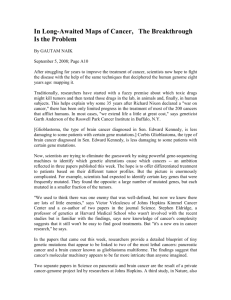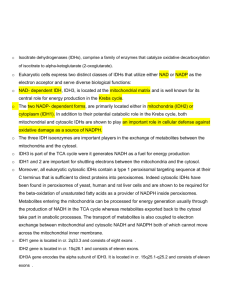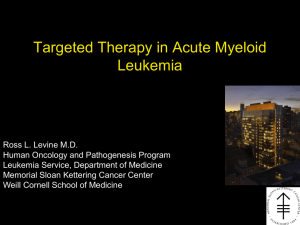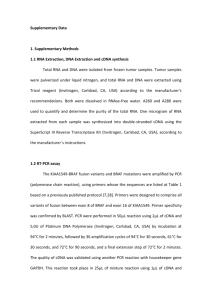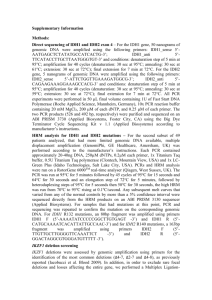原文 Two Gene Mutations Linked To Most Common Brain Cancers
advertisement
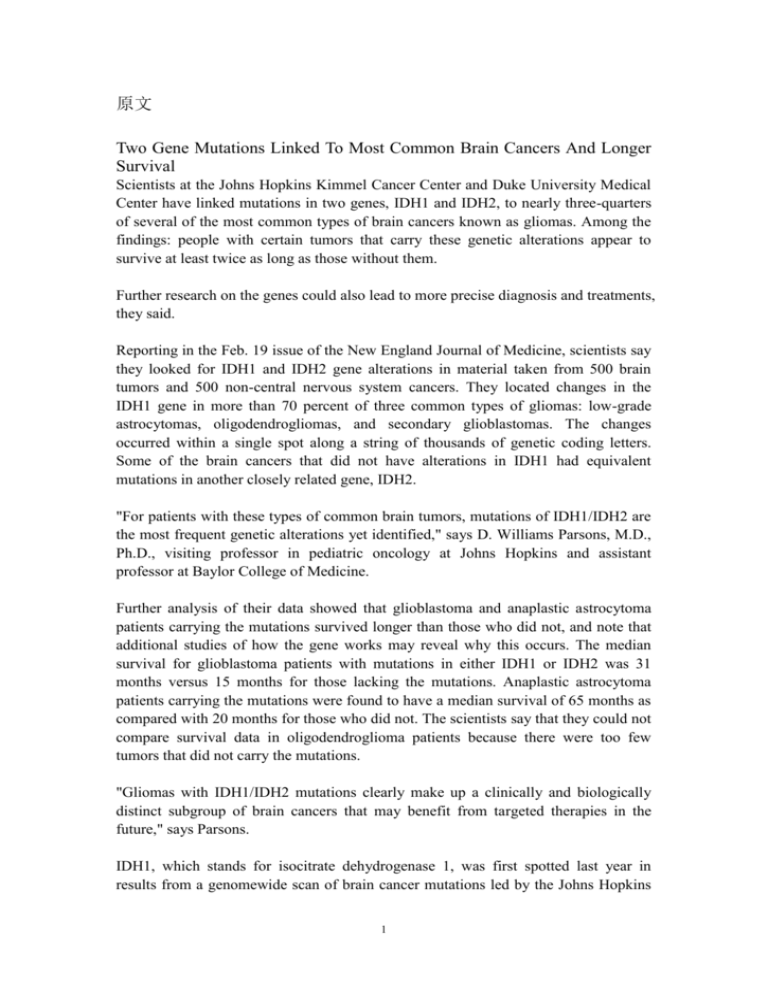
原文 Two Gene Mutations Linked To Most Common Brain Cancers And Longer Survival Scientists at the Johns Hopkins Kimmel Cancer Center and Duke University Medical Center have linked mutations in two genes, IDH1 and IDH2, to nearly three-quarters of several of the most common types of brain cancers known as gliomas. Among the findings: people with certain tumors that carry these genetic alterations appear to survive at least twice as long as those without them. Further research on the genes could also lead to more precise diagnosis and treatments, they said. Reporting in the Feb. 19 issue of the New England Journal of Medicine, scientists say they looked for IDH1 and IDH2 gene alterations in material taken from 500 brain tumors and 500 non-central nervous system cancers. They located changes in the IDH1 gene in more than 70 percent of three common types of gliomas: low-grade astrocytomas, oligodendrogliomas, and secondary glioblastomas. The changes occurred within a single spot along a string of thousands of genetic coding letters. Some of the brain cancers that did not have alterations in IDH1 had equivalent mutations in another closely related gene, IDH2. "For patients with these types of common brain tumors, mutations of IDH1/IDH2 are the most frequent genetic alterations yet identified," says D. Williams Parsons, M.D., Ph.D., visiting professor in pediatric oncology at Johns Hopkins and assistant professor at Baylor College of Medicine. Further analysis of their data showed that glioblastoma and anaplastic astrocytoma patients carrying the mutations survived longer than those who did not, and note that additional studies of how the gene works may reveal why this occurs. The median survival for glioblastoma patients with mutations in either IDH1 or IDH2 was 31 months versus 15 months for those lacking the mutations. Anaplastic astrocytoma patients carrying the mutations were found to have a median survival of 65 months as compared with 20 months for those who did not. The scientists say that they could not compare survival data in oligodendroglioma patients because there were too few tumors that did not carry the mutations. "Gliomas with IDH1/IDH2 mutations clearly make up a clinically and biologically distinct subgroup of brain cancers that may benefit from targeted therapies in the future," says Parsons. IDH1, which stands for isocitrate dehydrogenase 1, was first spotted last year in results from a genomewide scan of brain cancer mutations led by the Johns Hopkins 1 scientists. At the time, the scientists linked mutations in the IDH1 gene to roughly 12 percent of glioblastomas (or glioblastoma multiforme), the most lethal form of glioma. Add to this the newly discovered mutations occurring in lower grade astrocytomas and oligodendrogliomas, and Parsons estimates that 6,000 adults and children with brain cancer per year in the U.S. could be affected. "Pathologists may find it useful to determine IDH1/IDH2 status to help identify and classify these cancers," says Parsons. He added that proper diagnosis is essential because treatments differ within types of gliomas, as well as other forms of brain cancer. "New treatments could be designed to target the enzymatic activity that is altered by these mutations," says Victor Velculescu, M.D., Ph.D., associate professor and director of cancer genetics at the Ludwig Center at Johns Hopkins. "The mutations appear to occur very early in the progression of these cancers, perhaps at the stem cell level," adds Bert Vogelstein, M.D., Clayton Professor and co-director of the Ludwig Center at Johns Hopkins and a Howard Hughes Medical Institute investigator. Mutations were found by a standard technique of amplifying sections of the IDH1 and IDH2 genes through polymerase chain reaction (PCR), a process that replicates bits of DNA to levels that can be detected by sensitive computer equipment. The research was funded by the Pediatric Brain Tumor Foundation Institute, the Damon Runyon Foundation, the Southeastern Brain Tumor Foundation, Alex's Lemonade Stand Foundation, the V Foundation for Cancer Research, the Virginia and D.K. Ludwig Fund for Cancer Research, the Pew Charitable Trusts, the American Brain Tumor Association, the Brain Tumor Research Fund at Johns Hopkins, Beckman Coulter, and the Accelerate Brain Cancer Cure Foundation. Collaborating scientists include Hai Yan, M.D., Ph.D., Genglin Jin, Ph.D., Roger McLendon, M.D., B. Ahmed Rasheed, Ph.D., Ivan Kos, Ph.D., Ines Batinic-Haberle, Ph.D., Henry Friedman, M.D., Allan Friedman, M.D., David Reardon, M.D., James Herndon, Ph.D., and Darell D. Bigner, M.D., Ph.D., at Duke University Medical Center; Sian Jones, Ph.D., Gregory Riggins, M.D., Ph.D., and Kenneth Kinzler, Ph.D., from Johns Hopkins; and Weishi Yuan, Ph.D., from the Food and Drug Administration. Yan, Parsons, Jones, Kinzler, Velculescu, Vogelstein, and Bigner are eligible for royalties received by Johns Hopkins University on sales of products related to research described in this article, under licensing agreements between the University and Beckman Coulter. These agreements are being managed in accordance with 2 policies at the Johns Hopkins University. Johns Hopkins Medicine 901 S Bond St., Ste. 550 Baltimore MD 21231 United States http://www.hopkinsmedicine.org 文摘 N Engl J Med. 2009 Feb 19;360(8):765-73. IDH1 and IDH2 mutations in gliomas. Yan H, Parsons DW, Jin G, McLendon R, Rasheed BA, Yuan W, Kos I, Batinic-Haberle I, Jones S, Riggins GJ, Friedman H, Friedman A, Reardon D, Herndon J, Kinzler KW, Velculescu VE, Vogelstein B, Bigner DD Department of Pathology, Pediatric Brain Tumor Foundation Institute, Duke University Medical Center, Durham, NC 27710, USA. yan00002@mc.duke.edu BACKGROUND: A recent genomewide mutational analysis of glioblastomas (World Health Organization [WHO] grade IV glioma) revealed somatic mutations of the isocitrate dehydrogenase 1 gene (IDH1) in a fraction of such tumors, most frequently in tumors that were known to have evolved from lower-grade gliomas (secondary glioblastomas). METHODS: We determined the sequence of the IDH1 gene and the related IDH2 gene in 445 central nervous system (CNS) tumors and 494 non-CNS tumors. The enzymatic activity of the proteins that were produced from normal and mutant IDH1 and IDH2 genes was determined in cultured glioma cells that were transfected with these genes. RESULTS: We identified mutations that affected amino acid 132 of IDH1 in more than 70% of WHO grade II and III astrocytomas and oligodendrogliomas and in glioblastomas that developed from these lower-grade lesions. Tumors without mutations in IDH1 often had mutations affecting the analogous amino acid (R172) of the IDH2 gene. Tumors with IDH1 or IDH2 mutations had distinctive genetic and clinical characteristics, and patients with such tumors had a better outcome than those with wild-type IDH genes. Each of four tested IDH1 and IDH2 mutations reduced the enzymatic activity of the encoded protein. CONCLUSIONS: Mutations of NADP(+)-dependent isocitrate dehydrogenases encoded by IDH1 and IDH2 occur in a majority of several types of malignant gliomas. 2009 Massachusetts Medical Society PMID: 19228619 [PubMed - indexed for MEDLINE] 3

